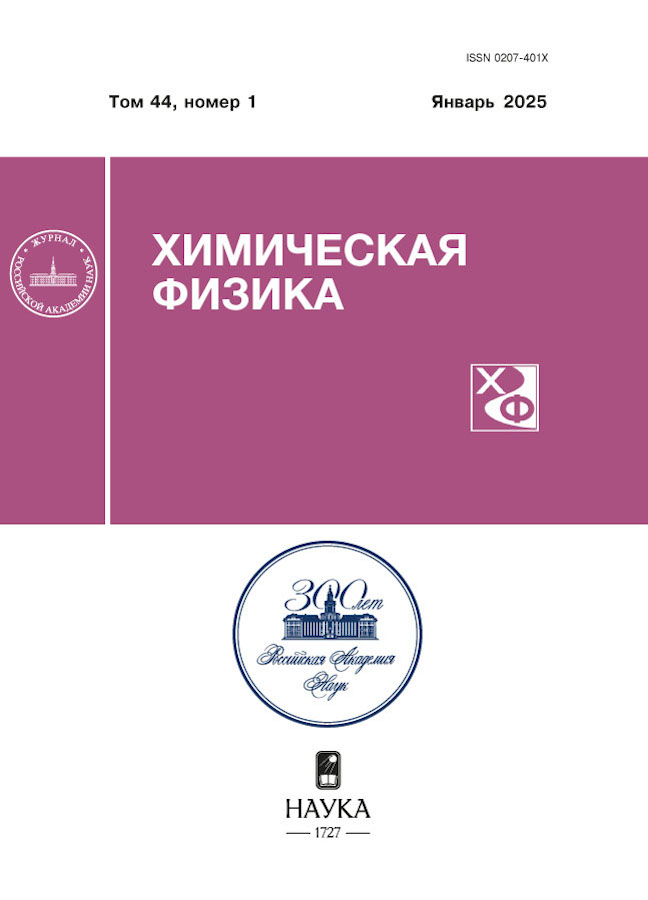Structure, conductivity and sensor properties of NiO–In2O3 composites synthesis by different methods
- Авторлар: Ikim M.I.1, Erofeeva A.R.1, Spiridonova E.Y.1, Gromov V.F.1, Gerasimov G.N.1, Trakhtenberg L.I.1,2
-
Мекемелер:
- Semenov Federal Research Center of Chemical Physics, Russian Academy of Sciences
- Lomonosov Moscow State University
- Шығарылым: Том 44, № 1 (2025)
- Беттер: 90-95
- Бөлім: Chemical physics of nanomaterials
- URL: https://cardiosomatics.ru/0207-401X/article/view/683326
- DOI: https://doi.org/10.31857/S0207401X25010105
- ID: 683326
Дәйексөз келтіру
Аннотация
The effect of the synthesis method of NiO–In2O3 composites on their structural, conductive and sensory characteristics when detecting hydrogen was studied. Impregnation of indium oxide nanoparticles with a nickel nitrate salt and a hydrothermal method with aqueous solutions of the corresponding salts were used. It has been shown that during the impregnation process, nickel oxide is formed in the form of amorphous nanoparticles on the surface of indium oxide, and during hydrothermal treatment, nickel ions are introduced into In2O3 structures. In impregnated composites, the particle size of indium oxide does not depend on the composition and is 60 nm, while in hydrothermal composites it decreases from 35 to 30 nm with increasing nickel content. With an increase in nickel content from 0 to 3 wt.% for both synthesis methods, the conductivity decreases, and the resistance for hydrothermal samples is an order of magnitude higher than for impregnated ones. The sensory response was almost twice as high.
Негізгі сөздер
Толық мәтін
Авторлар туралы
M. Ikim
Semenov Federal Research Center of Chemical Physics, Russian Academy of Sciences
Хат алмасуға жауапты Автор.
Email: ikimmary1104@gmail.com
Ресей, Moscow
A. Erofeeva
Semenov Federal Research Center of Chemical Physics, Russian Academy of Sciences
Email: ikimmary1104@gmail.com
Ресей, Moscow
E. Spiridonova
Semenov Federal Research Center of Chemical Physics, Russian Academy of Sciences
Email: ikimmary1104@gmail.com
Ресей, Moscow
V. Gromov
Semenov Federal Research Center of Chemical Physics, Russian Academy of Sciences
Email: ikimmary1104@gmail.com
Ресей, Moscow
G. Gerasimov
Semenov Federal Research Center of Chemical Physics, Russian Academy of Sciences
Email: ikimmary1104@gmail.com
Ресей, Moscow
L. Trakhtenberg
Semenov Federal Research Center of Chemical Physics, Russian Academy of Sciences; Lomonosov Moscow State University
Email: ikimmary1104@gmail.com
Ресей, Moscow; Moscow
Әдебиет тізімі
- Q. Li, W. Zeng, Y. Li. Sens. Actuators B. 359, 131579 (2022).
- C. Zhang, K. Xu, K. Liu, J. Xu, Z. Zheng, Coord. Chem. Rev. 472, 214758 (2022).
- K.G. Krishna, S. Parne, N. Pothukanuri, V. Kathirvelu, S. Gandi, D. Joshi. Sens. Actuators A. 341, 113578 (2022).
- L.I. Trakhtenberg, M.I. Ikim, O.J. Ilegbusi, V.F. Gromov, G.N. Gerasimov. Chemosens. 11, 320 (2023).
- S. Yan, W. Song, D. Wu, S. Jin, S. Dong, H. Hao, W. Gao, J. Alloys Compd. 896, 162887 (2022).
- M.I. Ikim, E.Y. Spiridonova, V.F. Gromov, G.N. Gerasimov, L.I. Trakhtenberg, Russ. J. Phys. Chem. B 17, 774 (2023).
- L.C. Jimenez, H.A. Mendez, B.A. Paez, M.E. Ramırez, H. Rodrıguez. Braz. J. Phys. 36, 1017 (2006).
- P. Prathap, D.G. Gowri, Y.P.V. Subbaiah, R.K.T. Ramakrishna, V. Ganesan // Current Appl. Phys. 8, 120 (2008).
- G.N. Gerasimov, V.F. Gromov, M.I. Ikim, L.I. Trakhtenberg. Russ. J. Phys. Chem. B 15, 1072 (2021).
- X. Fan, Y. Xu, W. He. RSC advances. 11, 11215 (2021).
- Y. Zhang, J. Cao, Y. Wang. Vacuum. 202, 111149 (2022).
- Z. Jin, C. Wang, L. Wu, H. Song, X. Yao, J. Liu, F. Wang. Sens. Actuators B. 377, 133058 (2023).
- M.I. Ikim, E.Y. Spiridonova, V.F. Gromov, G.N. Gerasimov, L.I. Trakhtenberg. Russ. J. Phys. Chem. B 16, 1180 (2022).
- V.F. Gromov, M.I. Ikim, G.N. Gerasimov, L.I. Trakhtenberg. Russ. J. Phys. Chem. B. 15, 1084 (2021).
- M.I. Ikim, E.Y. Spiridonova, V.F. Gromov, G.N. Gerasimov, L.I. Trakhtenberg. Russ. J. Phys. Chem. B. 18, 283 (2024).
- Y. Wang, M. Yao, R. Guan, Z. Zhang, J. Cao. J. Alloys Compd. 854, 157169 (2021).
- M.I. Ikim, V.F. Gromov, G.N. Gerasimov, E.Y. Spiridonova, A.R. Erofeeva, K.S. Kurmangaleev, L.I. Trakhtenberg. Micromachines. 14, 1685 (2023).
Қосымша файлдар











